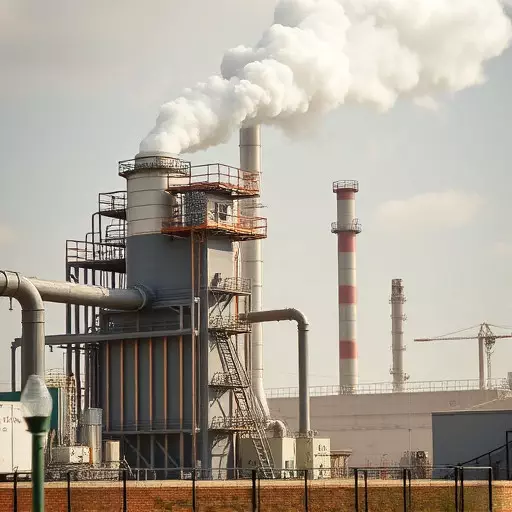Carbon filtration systems are powerful air quality solutions designed for industrial sites, effectively tackling dust collection and emission control. These advanced filters use activated carbon to capture pollutants, VOCs, and odours, ensuring cleaner air that meets emission standards. Their high efficiency in trapping fine particulate matter makes them ideal for industries seeking dust collection and emission control technologies. Versatile and adaptable, they can be used in ventilation systems and gas purification processes. Carbon filters are crucial for minimizing environmental impact, improving worker safety, and promoting sustainable practices in industrial settings. With continuous innovations, future systems aim to enhance efficiency, broaden pollutant capture, reduce costs, and integrate with other emission control methods.
Carbon filtration systems have emerged as indispensable tools for enhancing air quality, particularly at industrial sites. This comprehensive overview delves into the intricacies of these systems, exploring their multifaceted applications from dust collection to cutting-edge emission control technologies. We examine how carbon filters provide effective and efficient solutions for maintaining optimal air quality across diverse industries. From understanding the technology to future innovations, this article offers valuable insights into the global shift towards cleaner environments.
- Understanding Carbon Filtration Systems: A Comprehensive Overview
- Air Quality Solutions for Industrial Sites: The Role of Carbon Filters
- Dust Collection Solutions: How Carbon Technology Improves Efficiency
- Emission Control Technologies: Reducing Pollution with Carbon Filtration
- Types and Applications of Carbon Filtration Systems in Various Industries
- Future Trends and Innovations in Carbon Filtration Systems
Understanding Carbon Filtration Systems: A Comprehensive Overview
Carbon filtration systems are an effective and widely adopted technology for enhancing air quality in various industries. These advanced systems play a pivotal role in providing robust solutions for dust collection and emission control, particularly on industrial sites. By leveraging activated carbon media, these filters capture and remove pollutants, volatile organic compounds (VOCs), and even odours from the air stream.
The process involves passing contaminated air through a bed of activated carbon, where adsorption occurs. This mechanism traps harmful particles and gases, ensuring cleaner air is released into the environment or directed back into industrial processes. Carbon filtration offers numerous advantages, including high efficiency in capturing fine particulate matter and odours, making it an ideal choice for industries aiming to meet stringent emission standards. Moreover, these systems are versatile, adaptable to different applications, from ventilation systems to gas purification in various manufacturing processes.
Air Quality Solutions for Industrial Sites: The Role of Carbon Filters
Carbon filters play a pivotal role in providing effective air quality solutions for industrial sites. With industries generating significant volumes of harmful emissions and dust, implementing robust dust collection solutions is essential to mitigate environmental impact and ensure worker safety. Carbon filtration systems act as powerful tools in this regard, offering advanced emission control technologies that capture and neutralize pollutants effectively.
These systems are designed to trap fine particles, including toxic gases, volatile organic compounds (VOCs), and other noxious substances, preventing their release into the atmosphere. By integrating carbon filters into industrial processes, companies can achieve better air quality compliance, reduce environmental liabilities, and create a healthier work environment for their employees.
Dust Collection Solutions: How Carbon Technology Improves Efficiency
Carbon filtration systems offer advanced dust collection solutions, significantly enhancing air quality for industrial sites. By leveraging carbon technology, these systems excel in capturing and controlling fine particulate matter, which is a crucial aspect of emission control technologies. The porous structure of activated carbon allows it to effectively trap contaminants, ensuring cleaner air is released into the environment.
This improved efficiency stems from carbon’s ability to adsorb a wide range of pollutants, including organic compounds, odors, and volatile gases. In industrial settings, where dust collection solutions are essential for worker safety and environmental compliance, carbon filtration systems provide a reliable and sustainable answer. They contribute to better working conditions, reduce health risks for employees, and minimize the ecological impact by containing and reducing emissions from manufacturing processes.
Emission Control Technologies: Reducing Pollution with Carbon Filtration
Carbon filtration systems play a pivotal role in emission control technologies, offering powerful air quality solutions for industrial sites. These advanced systems are designed to capture and reduce harmful pollutants, including particulate matter and noxious gases, that are often released during industrial processes. By utilizing carbon filters, industries can significantly minimize their environmental impact and contribute to cleaner, healthier environments.
Carbon-based filtration is particularly effective in dust collection solutions, where it captures fine particles that traditional filters might miss. This ensures that the air expelled from industrial facilities is free from hazardous substances, preventing pollution and maintaining air quality standards. Emission control technologies equipped with carbon filtration become indispensable tools for industries aiming to meet environmental regulations while promoting sustainable practices.
Types and Applications of Carbon Filtration Systems in Various Industries
Carbon filtration systems play a pivotal role in enhancing air quality and emission control across various industries. These advanced technologies are designed to capture and remove contaminants, including particulate matter, volatile organic compounds (VOCs), and noxious gases, ensuring cleaner air for both indoor and outdoor environments. The versatility of carbon filtration is evident in its diverse applications.
In industrial settings, these systems serve as robust dust collection solutions, particularly effective for processes generating large volumes of airborne particles. From manufacturing facilities to power plants, they mitigate the risk of respiratory issues among workers and surrounding communities by filtering out hazardous pollutants. Moreover, carbon filtration is integral to air quality solutions for industrial sites aiming to meet stringent environmental regulations, contributing to a greener and healthier ecosystem.
Future Trends and Innovations in Carbon Filtration Systems
The future of carbon filtration systems appears promising, with continuous innovations aimed at enhancing their efficiency and adaptability. One notable trend is the development of advanced materials that can capture a broader spectrum of pollutants, including fine particulate matter and volatile organic compounds (VOCs). These materials are designed to be more durable, cost-effective, and environmentally friendly, making them ideal for both residential and industrial applications.
Additionally, there is a growing focus on integrating carbon filtration with other emission control technologies and dust collection solutions for industrial sites. Smart sensors and predictive analytics are being incorporated into these systems to monitor performance and optimize maintenance schedules, ensuring optimal air quality solutions. This integration not only improves overall system efficiency but also contributes to the reduction of environmental emissions, making them crucial components in the global effort to combat climate change and improve public health.


